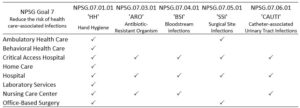The Joint Commission’s (JC) National Patient Safety Goals, what are effective from 2018 January are available now. What does the document say about hand hygiene?
JC is a non-profit organization that accredits and certifies almost 21,000 healthcare organizations and programs in the USA. The JC’s accreditation is voluntary, it reflects to the organization’s commitment to provide high quality services. By evaluating health care organizations, the JC helps to improve patient safety and quality of care.
The JC was founded in 1951, which makes it the oldest and largest standard-setting and accrediting body in healthcare in the United States. One of their divisions, the Joint Commission International accredits and certifies international healthcare organizations [1].
The National Patient Safety Goals (NSPG) program was initiated in 2002 by the JC. A Patient Safety Advisory Group determined the highest priority patient safety issues, and made suggestions how to address them. These are basically lists of interventions what a hospital should do. The Advisory Group updating the NSPG regularly, the newest protocols – effective from January 2018 – are now available.
NPGS has separate goals, and every goal has several elements. Goal 7 is “To reduce the risk of healthcare-associated infections”, which contains five sub-goals. For different organization types (programs), different goals should be applied [2].
 “Prevent infection” panel on the National Patient Safety Goals 2018. Source: The Joint Commission.
“Prevent infection” panel on the National Patient Safety Goals 2018. Source: The Joint Commission.
If we look only the “Prevent Infection” part, the only goal that is common in all programs is the NPSG07.01.01. It says, that the organization should apply a hand cleaning guideline, which could be the World Health Organization (WHO) hand hygiene guideline or the Centers for Disease Control and Prevention (CDC) hand hygiene guideline. Organization should also foster a culture of hand hygiene, monitor compliance and provide feedback [3].
The other 4 sub-goals have some common suggestions. Organization need to
- educate staff, patients and their families;
- apply evidence-based guidelines;
- document and measure (e.g., multidrug-resistant organism infections, central line-associated bloodstream infections, surgical site infections, catheter-associated urinary tract infections);
- evaluate the effectiveness of their infection prevention programs;
- provide data to stakeholders, including healthcare-workers.
Hospitals should submit reports to the JC regularly, and the data is available to the public. At QualityCheck.org, there is information about all accredited organizations, including a checklist indicating what National Patients Safety Goals are already implemented in the organization [4].
 Hospital where all the “Prevent Infection” panel goals are implemented. Source: www.qualitycheck.org
Hospital where all the “Prevent Infection” panel goals are implemented. Source: www.qualitycheck.org
CONCLUSION:
According to the National Patient Safety Goals, hospitals and other organizations should apply a hand cleaning program, either following the Hand Hygiene Guidelines of WHO or CDC. Hospitals should monitor HH compliance and report it. They should also measure healthcare-associated infections and educate staff and patients about the importance of infection prevention.
Read our previous posts on the Electronic Compliance Monitoring Systems, and How Effective is Hand Hygiene